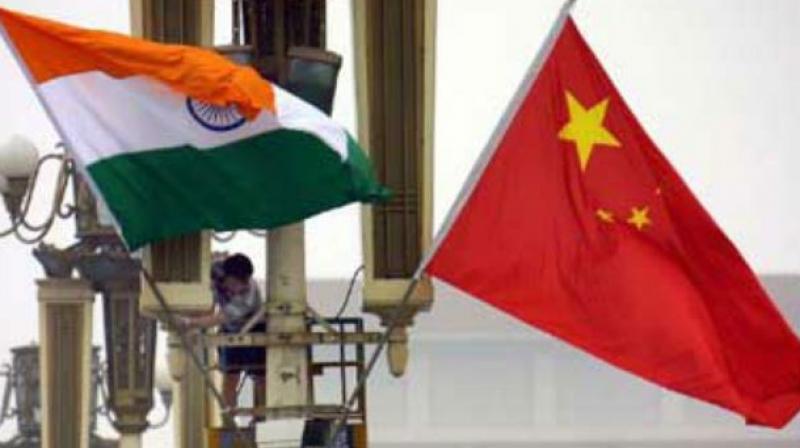The protracted talks between foreign ministers S. Jaishankar and Wang Yi in Moscow have gained India and China a reprieve. Before they began, the two countries were poised on the knife edge of war. Now they have moved back. Something has been gained: a reassurance before the eyes of the world that neither country wants a war and that both will reactivate long dormant mechanisms to maintain a more constant contact with each other as they search for ways to find a solution from which they can both emerge as winners.
But is there such a solution? And if Beijing and Delhi can’t find one, how long will the reprieve last?
A close look at the content of the talks shows that the prospects for a lasting peace are not good. This is because the core of the problem has remained untouched: Wang Yi urged that the two countries should put the border dispute into cold storage and concentrate on intensifying cooperation on the many global issues where they share a common interest or perspective. China, he said, views India as a partner, not an adversary.
Winter, a temporary reprieve?
Jaishankar was equally keen on a détente but insisted that the starting point had to be a return by Chinese troops to the positions they occupied had occupied in April. Nothing less would be acceptable to his government. So, we are back to the question that has prevented a de-escalation of the confrontation since June: who will blink first?
Neither country wants a war.
But Modi has never blinked first in his entire life and is unlikely to do so now. Xi is reported to be equally adamant, but possibly for different reasons. So, there is no guarantee that war will not break out at some time in the future, in the way that most wars in history have begun – from the misjudgment by one protagonist of the likely reaction to its threats or inducements by the other.
The most we can therefore realistically hope for is that, as happened in the Doklam confrontation, the approach of winter at 5,000 metres plus will be made the excuse for disengagement now and that both countries will use the time it gives them for cooler reflection on how they have managed to get from a near-fraternal relationship six years ago to a point where millions in each country are baying for the other’s blood.
China is undoubtedly the country that has triggered the confrontation. But it should be apparent to those not numbed by hyper-nationalism, that it has not done so simply to grab a sliver of additional territory in the Himalayas, whose economic value to it is less than negligible.
If we can give credence to the statements of the foreign office in Beijing and the Chinese embassy in Delhi, China has acted the way it has because it believes India is no longer abiding by the understandings upon which the 1993 Agreement on Peace and Tranquility in the Border Areas, and its subsequent elaboration in 2005, were signed, and has therefore ceased to be a reliable treaty partner.
China’s tactics in Ladakh are therefore designed to force a reconsideration of relations between the two countries. Whether we return to peace or continue to drift towards war will, therefore, depend on whether India can reassure China that it has every intention of honouring the existing agreements not only in letter but also in spirit.
Why hasn’t Modi called up Xi Jinping?
What is difficult to understand is Modi’s enigmatic silence. Had he called Xi Jinping on the hotline in May, Jaishankar and his counterpart would have reached the conclusions they arrived at Moscow at least three months ago. What is more, their talks would have taken place within a framework of discussion already established by their leaders, instead of in the policy vacuum that exists today.
Had Modi done so, he would not have been breaking protocol, or weakening India’s position by displaying undue anxiety, because the two leaders had agreed, at Astana in 2017, to meet frequently to discuss strategies and resolve issues, and had done so twice already at Wuhan in 2018, and Mahabalipuram in 2019.
We can only speculate on the reasons why Modi chose not to do so. But his silence has turned the gamble he is taking now into a carbon copy of the one Jawaharlal Nehru took when he ordered the army to push the Chinese off the Thagla ridge in 1962. This is that if India stands firm and continues to match Chinese troop build-ups in the area with its own, China will withdraw rather than fight India and incur the opprobrium of the world.
This is not a gamble that any leader of a country should take. Two clashes between Chinese and Indian soldiers so far have been immediately controlled. But this unstable equilibrium will not last if Delhi is not able to identify, and address, the concerns that made China change the rules of the game, and find ways to ameliorate them.
These can be deduced by revisiting the 2005 Agreement on the Political Parameters and Guiding Principles for the Settlement of the India-China Boundary Question and examining how far Modi’s India has strayed from them.
Key commitments in 2005
The agreement contains 11 clauses, described as ‘articles’. The key phrase in the first article: “The differences on the boundary question should not be allowed to affect the overall development of bilateral relations…” is a tacit admission that, as of 2005, the Chinese government had not been able to get over hurdles to the delineation of the boundary placed by one or more power centres within it. Its refusal, or inability, to provide China’s maps of the region to reconcile with India’s maps – a pre-requisite for boundary demarcation – suggests that the hurdle was the Peoples’ Liberation Army.
The 2005 agreement’s purpose, therefore, was to prevent its objections from becoming roadblocks to widening cooperation in other areas. Implicit in this was the assumption that as the areas of Sino-Indian cooperation on global political and economic issues increased, these internal reservations would automatically weaken and disappear.
Three other articles spelt out the key sensitivities of both sides that needed to be kept in mind if cooperation on global issues was to deepen:
· “The two sides will give due consideration to each other’s strategic and reasonable interests, and the principle of mutual and equal security. (Article iv);
· The two sides will take into account historical evidence, national sentiments, practical difficulties and reasonable concerns and sensitivities of both sides, and the actual state of border areas; (Article v);
· “In reaching a boundary settlement, the two sides shall safeguard due interests of their settled populations in the border areas (Article vii).
The first two spelt out China’s concerns, the third India’s concern over the status of Tawang.
Today, 15 years later, China has, by and large, kept its side of the bargain; but after rapidly deepening strategic cooperation with the United States under the UPA, India, under Modi and the BJP, has gone out of its way to trash the Indian side of the bargain.
Richard Verma’s visit to Tawang
Here is a brief account of how thoroughly he has done so: Exactly a week after Xi Jinping’s state Visit to India in September 2014, Modi went to the US to attend the UN General Assembly, but also visited the White House and, apparently without any prior discussion with the foreign office, completely and unconditionally aligned India with the US in the Asia-Pacific region.
Less than four months later, on January 25, 2015, he and Obama, who had hastened to Delhi to be the chief guest at the Republic day parade, announced a Joint Strategic Vision for the Asia-Pacific and the Indian Ocean, whose immediate purpose, minus the fluff, was to assert freedom of navigation in the South China Sea.
In February 2016, India sent four warships to join a US-Japan task force for three months to assert freedom of navigation in the South China Sea. In the same period, the US consul general in Calcutta visited Itanagar and declared that, as far as the US was concerned, Arunachal Pradesh was ‘indisputably’ a part of India.
Weeks later, Modi gave permission to not only the Dalai Lama but also to Richard Verma, the US ambassador to India, to visit Tawang for the annual Tawang festival. This was a deliberate waving of a red rag before a bull, for China had originally claimed all of Arunachal Pradesh including Tawang, and had only stopped openly doing so after Wen Jiabao’s meeting with Prime Minister Manmohan Singh at Hua Hin, Thailand, in 2009.
China was, at first, reluctant to let its relationship with India worsen. It, therefore, reacted with notable restraint. When the US Consul General made his statement Beijing contented itself with saying : “China and India are wise, and capable, enough to deal with their own issues and safeguard the fundamental and long-term interests of the two peoples. The intervention of any third party will only complicate the issue and is highly irresponsible.”
When Indian ships joined the US-Japanese task force in May, it again refrained from criticising India directly and accused the US, instead, of following a ‘divide and rule’ colonial policy towards the two Asian giants.
Asked to comment, all that an unnamed senior official of the Chinese foreign office was willing to say was “When there is some trouble in the South China Sea, India is worried. When Indian ships participate in maritime exercises in the South China Sea, of course China will show concern.”
It was only after Richard Verma’s visit to Tawang for the monastery’s annual festival that Lu Kang, a foreign office spokesperson, said in Beijing on October 24, 2016 China is “firmly opposed” to the U.S. diplomat’s actions, “which will damage the hard-earned peace and tranquillity of the China-India border region… Any responsible third party should respect efforts by China and India to seek peaceful and stable reconciliation, and not the opposite”.
The statement was mild, and carefully avoided using language that could be construed as a warning to India. But Beijing’s use of the phrase “peace and tranquillity” should have rung warning bells in South Block because language is of paramount importance in diplomacy.
The use of that precise phrase, the heading of the 1993 agreement, was China’s first reminder that India was flouting solemnly entered agreements with it. If Delhi went any further down that road, the implication was, China would consider the agreement to have been abrogated.
South Block would doubtless have heard them, but Modi either did not listen, or did not care.
For between 2016 and 2018, India signed two defence-related agreements with the US – the Logistics Exchange Memorandum of Agreement (LEMOA) and the Communications Compatibility and Security Agreement (COMCASA), whose goal is to enable the two countries’ navies to coordinate all their actions whether in disaster relief or in defence.
Only one more agreement, the Basic Exchange and Cooperation Agreement (BECA), remains to be signed to make inter-operability of the two defence forces complete. Had COVID-19 not struck the world, that too would have been done earlier this year.
Maritime domain: Operation Malabar
India has also joined enthusiastically in Operation Malabar, an annual naval exercise that had been a tepid affair in the days of the UPA; held three of its exercises in the Bay of Bengal, and actively campaigned to bring South Korea and Singapore into the original ‘Quad’ of the US, India, Japan and Australia. One of the war games in Operation Malabar is the closing of the Malacca straits through which 80% of China’s oil imports and 40% of its exports flow.
India has also modernised its naval and air bases in the Andamans and, in a tit-for-tat with China, is seeking to build a port at Subang in Indonesia at the mouth of the Malacca straits and, supposedly, exploring the possibility of a similar venture in Vietnam to create a pressure point at the entrance to the South China Sea. Since the confrontation in Ladakh began, speculation has been rife that India is making these investments to check the rise of China’s influence in the Indian Ocean region.
The above description shows how far Modi has taken India from the solemn commitments it made to China in 1993 and elaborated in 2005.
It therefore gives us little reason to expect a lasting peace in the future. The most that the Jaishankar-Wang Yi meeting has given us therefore is time – a reprieve from conflict, that will last through winter.
If the Modi government does not use it to reassess where the country’s national interest truly lies, put it ahead of party interest and give China a credible assurance that his government intends to abide by the commitments its predecessors entered into, not only in letter but also in spirit, then another war in the Himalayas will become a winnable bet.
































